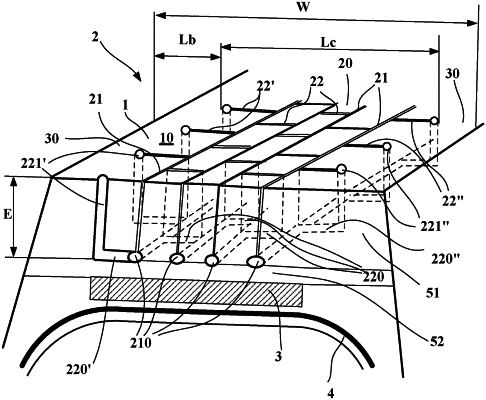| CPC B60C 11/0323 (2013.01) [B60C 11/033 (2013.01); B60C 11/124 (2013.01); B60C 11/1204 (2013.01); B60C 11/1236 (2013.01); B60C 11/1259 (2013.01); B60C 11/1281 (2013.01); B60C 2011/1209 (2013.01); B60C 2011/1227 (2013.01); B60C 2011/1245 (2013.01); B60C 2200/06 (2013.01)] | 14 Claims |

|
1. Tread for a tire to equip a heavy-duty trailer, this tread having:
a thickness E of material in a new state to be worn away that determines a wear limit, a tread surface for coming into contact with a road surface, this tread being divided into:
a central part and
edge parts on either side of the central part, the edge parts not having any transverse cuts,
wherein the central part is provided with a tread pattern that does not have any circumferential grooves, this tread pattern comprising:
a plurality of sipes, comprising:
at least two circumferential sipes; and
transverse sipes, including a first set of lateral sipes arranged between the two circumferential sipes and a second set of lateral sipes each extending axially from a respective one of the two circumferential sipes towards a tread edge, each of these first and second sets of lateral sipes comprising a first end close to the mid-plane of the tread and a second end axially outside the first end, the second ends of the second set of lateral sipes axially delimiting a border between the edge parts and the central part of the tread, each lateral sipe opening at its first end into a circumferential sipe instead of a channel that opens onto the tread surface and continues into the thickness of the tread,
wherein the first set of lateral sipes and second set of lateral sipes are circumferentially offset from each other,
all the sipes of the central part of the tread extending in the tread to a depth at least equal to 60% of the thickness E of material to be worn away and being extended into the tread by circumferentially extending and axially extending hidden channels of appropriate dimensions for supplementing a continuous fluidic flow network under the tread surface in the new state, these hidden channels being adapted to form grooves after a predetermined amount of partial wear,
wherein the tread is entirely without grooves in its central part, this central part having a width at least equal to 40% and at most 90% of the total width W of the tread, and
wherein the second set of lateral sipes formed in the central part of the tread open at their second end into an end channel that opens onto the tread surface of the tread and continues into the thickness of said tread until it meets a hidden channel at the sipe bottom,
wherein the circumferential sipes, the lateral sipes and the hidden channels create a grid network forming the continuous fluidic flow network at a predetermined depth,
wherein each end channel that opens onto the tread surface of the tread is arranged at the border between the edge parts and the central part,
wherein each end channel, is at a respective axial outer end of the grid network and has only one of the second set of lateral sipes extending axially therefrom towards an axial center of the tread.
|
|
14. A tread for a tire to equip a heavy-duty trailer, this tread having:
a thickness E of material in a new state to be worn away that determines a wear limit, a tread surface for coming into contact with a road surface, this tread being divided into:
a central part and
edge parts on either side of the central part, the edge parts not having any transverse cuts,
wherein the central part is provided with a tread pattern that does not have any circumferential grooves, this tread pattern comprising:
a plurality of sipes, comprising:
at least two circumferential sipes; and
transverse sipes, including a first set of lateral sipes arranged between the two circumferential sipes and a second set of lateral sipes each extending axially from a respective one of the two circumferential sipes towards a tread edge, each of these first and second sets of lateral sipes comprising a first end close to the mid-plane of the tread and a second end axially outside the first end, the second ends of the second set of lateral sipes axially delimiting a border between the edge parts and the central part of the tread, each lateral sipe opening at its first end into a circumferential sipe,
all the sipes of the central part of the tread extending in the tread to a depth at least equal to 60% of the thickness E of material to be worn away and being extended into the tread by circumferentially extending and axially extending hidden channels of appropriate dimensions for supplementing a continuous fluidic flow network under the tread surface in the new state, these hidden channels being adapted to form grooves after a predetermined amount of partial wear,
wherein the tread is entirely without grooves in its central part, this central part having a width at least equal to 40% and at most 90% of the total width W of the tread, and
wherein the second set of lateral sipes formed in the central part of the tread open at their second end into an end channel that opens onto the tread surface of the tread and continues into the thickness of said tread until it meets a hidden channel at the sipe bottom, and thus creates the continuous fluidic flow network between all the channels, regardless of whether they are lateral or hidden,
wherein each end channel that opens onto the tread surface of the tread is arranged at the border between the edge parts and the central part,
wherein the edge parts do not have any circumferentially oriented grooves or sipes.
|